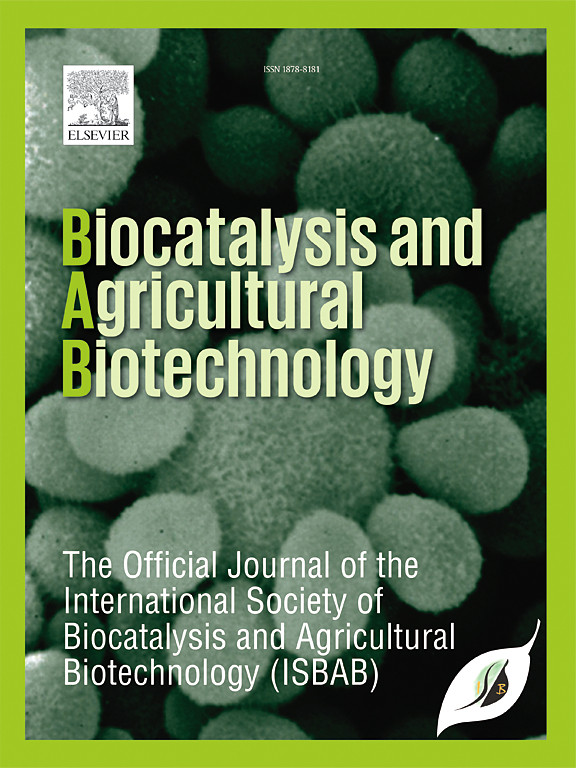协调传统和生物技术方法,设计作物微生物组:加强复原力优化
IF 3.4
Q2 BIOTECHNOLOGY & APPLIED MICROBIOLOGY
引用次数: 0
摘要
植物经常面临非生物和生物胁迫,对植物的生长和发育产生重大影响,并最终降低作物产量。这些复杂多变的胁迫因素对全球粮食安全构成了重大挑战。利用植物相关微生物组是提高农业可持续性的关键策略。在当今时代,植物微生物组工程领域受到了广泛关注,并蕴含着彻底改变新型农业管理方法的巨大潜力。然而,许多研究主要集中于解决单个压力因素,而对错综复杂的相互作用基本未作探讨。因此,这项工作探究了经典的生物技术和/或 "原子 "技术,以设计植物微生物组来克服多重胁迫。对土壤改良剂、选择性基质和有机农业实践等用于植物微生物组工程的传统方法进行了评估。还讨论了其他更直接、更先进的多组学方法,如计算和合成生物学、宿主基因组操作、微生物组培育和微生物组移植。此外,还综述了病原体感染和非生物胁迫的综合影响,特别强调了干旱胁迫。此外,还强调了植物生长促进微生物(PGPM)作为植物微生物组的一部分所发挥的重要作用。最后,这项工作揭示了不同有机农业和高通量先进战略之间的相互作用,其最终目标是重塑植物微生物组,为可持续农业实践铺平道路。本文章由计算机程序翻译,如有差异,请以英文原文为准。
Harmonizing traditional and biotechnological approaches to engineer crop microbiomes: Enhancing resilience optimization
Plants are constantly confronted with both abiotic and biotic stresses, significantly affecting plant growth, development, and ultimately reducing crop yield. These complex and dynamic stress factors constitute a significant challenge to global food security. Harnessing plant-associated microbiomes represents a key strategy for enhancing agricultural sustainability. In the current era, the field of plant microbiome engineering has acquired significant attention and holds vast potential to revolutionize novel agricultural management practices. Yet, many studies have primarily focused on addressing individual stressors, leaving the intricate interactions largely unexplored. Therefore, this work inquires into the classical and biotechnological and/or ¨omic¨ techniques to engineer plant microbiomes to overcome multiple stressors. Traditional methods such as soil amendments, selective substrates and organic agricultural practices for plant microbiome engineering, are evaluated. Other more direct and advanced multi-omics approaches, such as computational and synthetic biology, host genome manipulation, microbiome breeding and microbiome transplantation, are discussed. The combined effects of pathogen infections and abiotic stresses, with particular emphasis on drought stress, are also reviewed. In addition, the imperative role of plant-growth-promoting microorganisms (PGPM) as part of the resilient plant microbiome is also highlighted. Lastly, this work sheds light on the interplay between different organic agricultural and high-throughput advanced strategies, with the final goal of reshaping the plant microbiome and pave the way for sustainable agricultural practices.
求助全文
通过发布文献求助,成功后即可免费获取论文全文。
去求助
来源期刊

Biocatalysis and agricultural biotechnology
Agricultural and Biological Sciences-Agronomy and Crop Science
CiteScore
7.70
自引率
2.50%
发文量
308
审稿时长
48 days
期刊介绍:
Biocatalysis and Agricultural Biotechnology is the official journal of the International Society of Biocatalysis and Agricultural Biotechnology (ISBAB). The journal publishes high quality articles especially in the science and technology of biocatalysis, bioprocesses, agricultural biotechnology, biomedical biotechnology, and, if appropriate, from other related areas of biotechnology. The journal will publish peer-reviewed basic and applied research papers, authoritative reviews, and feature articles. The scope of the journal encompasses the research, industrial, and commercial aspects of biotechnology, including the areas of: biocatalysis; bioprocesses; food and agriculture; genetic engineering; molecular biology; healthcare and pharmaceuticals; biofuels; genomics; nanotechnology; environment and biodiversity; and bioremediation.
 求助内容:
求助内容: 应助结果提醒方式:
应助结果提醒方式:


